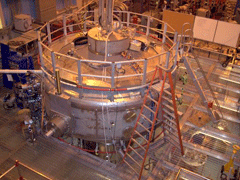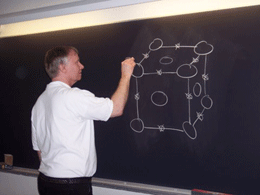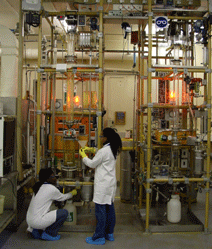Fusion or Illusion
| This week, Living on Earth looks at the promise of fusion energy.It's easy to see why physicists say fusion is the energy source of the future. The fuel for fusion is virtually unlimited.
It's a form of hydrogen that's available by the oceans-full, and when the nuclei are forced together, or fused, they produce enormous amounts of energy that's practically pollution-free. It may sound too good to be true, but physicists say while the technical challenges are enormous, it is possible. Over the past sixty years, scientists have been developing larger and larger devices in their labs that will mimic the way fusion energy is produced in stars. And recently, the international science community announced the construction of the largest fusion device ever conceived and predict it will demonstrate that fusion really is the "energy source of the future." But critics say the twelve billion dollar experiment will never be economically viable and quip, fusion is indeed the energy source of the future and always will be.
March 23, 1989 is the beginning of what’s been called "the greatest controversy in basic science in the 20th century." That’s the day two scientists at the University of Utah told reporters at a news conference that they had created fusion in a test tube at room temperatures.
Skeptics immediately denounced the discovery saying it violated the fundamental laws of physics. A scientific panel convened by the Department of Energy concluded so-called "cold fusion" was not a nuclear reaction and did not produce excess energy. For most scientists, cold fusion was dead and buried. But over the last sixteen years later a small group of scientists have continued to investigate the phenomenon, and say not only is cold fusion is alive, real, and reproducible, it will soon provide unlimited, and virtually pollution-free energy.
Nuclear power held great promise when it came online in the 1960s and 70s. Utilities promised nuclear plants would produce electricity that was clean and cheap, and reduce dependence on foreign oil.
But technical problems, high costs, and a change of public opinion turned the tides against nuclear power and during the last two decades, the nuclear industry was a boondoggle. But today, nuclear power may be experiencing a comeback. High oil and gas prices and the threat of global warming have forced many to give nuclear energy a second chance. Living on Earth travels to South Africa to take a look at pebble bed reactors--small-scale, affordable, high temperature plants. Scientists there say this technology will bring nuclear energy that’s safe to the developing world and other nations.
|
|
| ||
Back to the series and features homepage
Living on Earth wants to hear from you!
Living on Earth
62 Calef Highway, Suite 212
Lee, NH 03861
Telephone: 617-287-4121
E-mail: comments@loe.org
Newsletter [Click here]
Donate to Living on Earth!
Living on Earth is an independent media program and relies entirely on contributions from listeners and institutions supporting public service. Please donate now to preserve an independent environmental voice.
NewsletterLiving on Earth offers a weekly delivery of the show's rundown to your mailbox. Sign up for our newsletter today!
 Sailors For The Sea: Be the change you want to sea.
Sailors For The Sea: Be the change you want to sea.
 Creating positive outcomes for future generations.
Creating positive outcomes for future generations.
 Innovating to make the world a better, more sustainable place to live. Listen to the race to 9 billion
Innovating to make the world a better, more sustainable place to live. Listen to the race to 9 billion
 The Grantham Foundation for the Protection of the Environment: Committed to protecting and improving the health of the global environment.
The Grantham Foundation for the Protection of the Environment: Committed to protecting and improving the health of the global environment.
 Contribute to Living on Earth and receive, as our gift to you, an archival print of one of Mark Seth Lender's extraordinary wildlife photographs. Follow the link to see Mark's current collection of photographs.
Contribute to Living on Earth and receive, as our gift to you, an archival print of one of Mark Seth Lender's extraordinary wildlife photographs. Follow the link to see Mark's current collection of photographs.
 Buy a signed copy of Mark Seth Lender's book Smeagull the Seagull & support Living on Earth
Buy a signed copy of Mark Seth Lender's book Smeagull the Seagull & support Living on Earth




